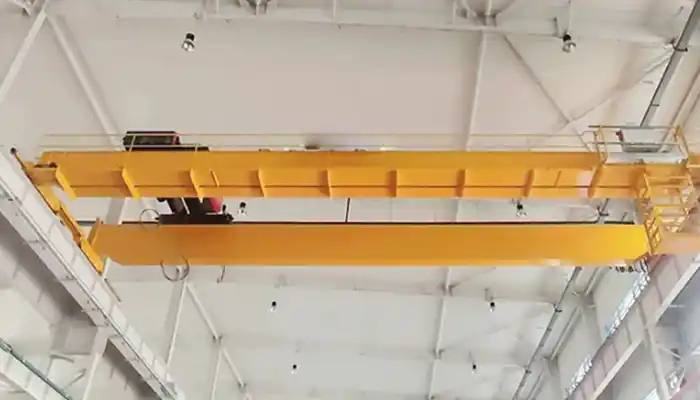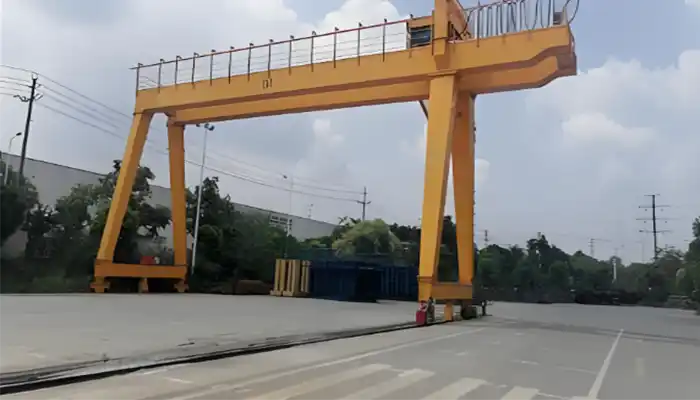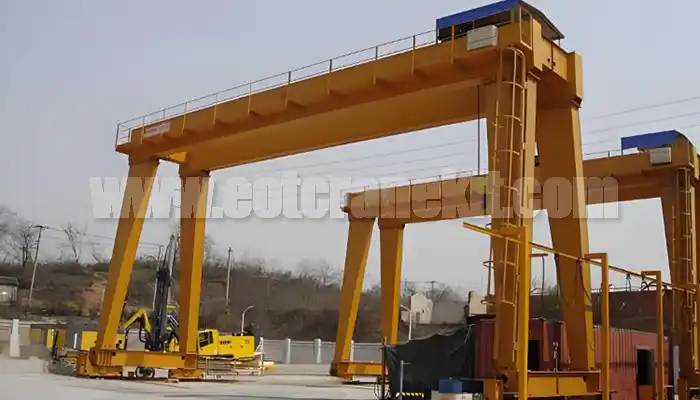Electric Overhead Crane Speed, Speed Control & Customization
Overhead electric crane comprehensive guide on speed, speed control & customization. Single speed, double speed, variable speed, which is best for you?
Category: Crane Basics
Your Trusted Overhead Crane Manufacturer & Supplier
Electric Overhead Crane Speed, Speed Control & Customization
Overhead electric crane comprehensive guide on Speed, speed control & customization. Single speed, double speed, variable speed, which is best for you?
Comprehensive Guide to Overhead Electric Crane Speed, Speed Control & Customization
Electric overhead cranes are the workhorses of many industrial sectors, seamlessly lifting and transporting heavy loads with precision and efficiency. In factories, warehouses, and construction sites, these cranes play a pivotal role in streamlining operations and boosting productivity. However, behind their seemingly simple functionality lies a crucial aspect that often gets overlooked: speed.
Speed Specifications
When it comes to electric overhead cranes, speed is not a one-size-fits-all affair. Different tasks demand different velocities to ensure optimal performance and safety. Let's break down the speed specifications of these cranes:
- Long Traveling Speed: Refers to the speed at which a crane or hoist moves along its runway or track over long distances. It measures how fast the crane can traverse horizontally from one end of the workspace to the other.
- Hoisting Speed: Indicates the rate at which the hoist mechanism raises or lowers a load vertically. It measures the speed of lifting or lowering the load, determining the efficiency of material handling operations.
- Cross Traveling Speed: Denotes the speed at which a crane's trolley moves perpendicular to the direction of its main travel. It measures the lateral movement of the trolley along the bridge or gantry, facilitating the positioning of loads across the workspace.
These speed specifications is key to harnessing the full potential of electric overhead cranes. From horizontal traversing to vertical lifting, each speed parameter plays a vital role in optimizing crane performance and ensuring smooth operations in industrial environments. But there's more to crane speed than meets the eye. Stay tuned as we explore the factors influencing speed and how to customize it to meet your specific needs.
General Speed of Single Girder Crane
The speed of a crane mainly depends on its type and application scenario, including lifting speed, trolley travel speed, and bridge travel speed. These speeds are typically measured in m/s or m/min, as follows:
Lifting Speed/ Hosting Speed : This refers to the speed at which the crane lifts a load. Generally, the lifting speed ranges from 8-12 m/min. For heavy lifting, the speed might be between 0.3-8 m/min.
Bridge Travel Speed/Long Traveling Speed : This is the speed at which the crane moves along its tracks. This speed is usually faster, typically ranging from 2-20 m/min.
Trolley Travel Speed/ Cross Travelling Speed : For overhead cranes, the trolley's speed on the tracks is generally between 2-20 m/min.
Additionally, there is the gantry crane travel speed, which usually considers the operator's comfort and ease of operation. The standard speed is 20 m/min, but it can be slightly faster during idle operation, reaching up to 30 m/min. For special applications, custom speeds can be designed according to user requirements.
It is important to note that the self-traveling speed of the crane should not exceed 3 km/h in specific situations (such as on turntables, near end stops, entering/exiting buildings, etc.). These speed settings are intended to ensure the safe operation of the crane and the convenience of its operation.

LD Single Girder Overhead Crane
Capacity: 1-25t
- Span: 7.5-35m
- Lifting height: 6-30m
- Lifting speed: 0.3-8m/min
- Hoist running speed: 20m/min
- Crane running speed: 20m/min
- Work duty: A3, A4
- Custom designs available
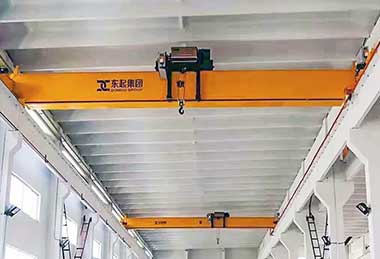
HD European Single Girder Crane
Capacity: 1-20t
- Span: 7.5-28.5m
- Lifting height: 6-18m
- Lifting speed: 0.8/5m/min
- Hoist running speed: 2-20m/min
- Crane running speed: 3-30m/min
- Work duty: A5
- Custom designs available
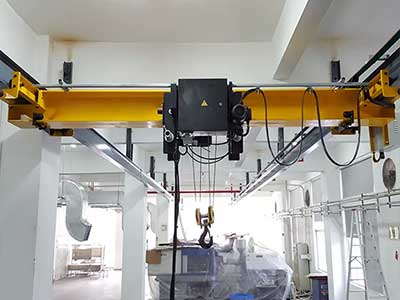
NLX Single Girder Underhung Crane
Capacity: 0.5-10t
- Span: 3-25m
- Lifting height: 6-30m
- Lifting speed: 0.7-8m/min
- Hoist running speed: 20m/min
- Crane running speed: 20m/min
- Work duty: A3, A4
- Custom designs available
Here's the information provided in a table format, organized by the type of single girder crane and its corresponding speed parameters:
Crane Type | Lifting Speed (m/min) | Hoist Running Speed (m/min) | Crane Running Speed (m/min) | Span (m) | Lifting Height (m) | Capacity (t) | Work Duty | Custom Designs Available |
LD Single Girder Overhead Crane | 0.3-8 | 20 | 20 | 7.5-35 | 6-30 | 1-25 | A3, A4 | Yes |
HD European Single Girder Crane | 0.8/5 | 2-20 | 3-30 | 7.5-28.5 | 6-18 | 1-20 | A5 | Yes |
LX Single Girder Underhung Crane | 0.7-8 | 20 | 20 | 3-25 | 6-30 | 0.5-10 | A3, A4 | Yes |
This table summarizes the key speed parameters for each type of single girder crane, including lifting speed, hoist running speed, and crane running speed, along with other specifications such as span, lifting height, capacity, work duty, and custom designs availability.
Comparison table organized by speed parameters:
Crane Type | Lifting Speed (m/min) | Hoist Running Speed (m/min) | Crane Running Speed (m/min) |
HD European Single Girder Crane | 0.8/5 | 2-20 | 3-30 |
LX Single Girder Underhung Crane | 0.7-8 | 20 | 20 |
LD Single Girder Overhead Crane | 0.3-8 | 20 | 20 |
This table organizes the crane types based on their lifting speed, hoist running speed, and crane running speed, making it easier to compare their performance in terms of speed capabilities.
General Speed of Double Girder Cranes

Parmeters of QD Double Girder Overehead Cranes
Load capacity: 5-450 tons
Span: 10.5-35 meters
Lifting height: 6-24 meters
Lifting speed: 1-15 meters per minute
Trolley running speed: 27-40 meters per minute
Crane running speed: 42-75 meters per minute
Work duty: A3-A7
Custom designs available

Parmeters of QDX Double Girder Overehead Cranes
Load capacity: 5-320 tons
Span: 10.5-35 meters
Lifting height: 6-24 meters
Lifting speed: 0.2-10.7 meters per minute
Trolley running speed: 4-33 meters per minute
Crane running speed: 2-68 meters per minute
Work duty: A3-A5
Custom designs available

Parmeters of LH Double Girder Overehead Cranes
Load capacity: 5-50 tons
Span: 10.5-35 meters
Lifting height: 6-30 meters
Lifting speed: 0.18-8 meters per minute
Trolley running speed: 20 meters per minute
Crane running speed: 20 meters per minute
Work duty: A3, A4
Custom designs available
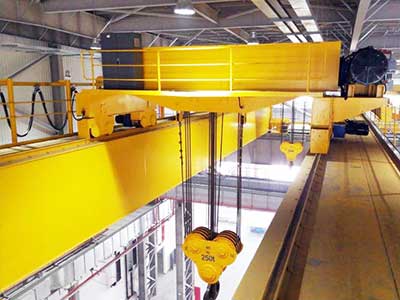
Parmeters of NLH Double Girder Overehead Cranes
Load capacity: 5-80 tons
Span: 10.5-35 meters
Lifting height: 6-18 meters
Lifting speed: 0.4-5 meters per minute
Trolley running speed: 2-20 meters per minute
Crane running speed: 3-30 meters per minute
Work duty: A5
Custom designs available
Here's the information presented in a table format:
Parameter | QD | QDX | LH | NLH |
Load Capacity (tons) | 5-450 | 5-320 | 5-50 | 5-80 |
Span (m) | 10.5-35 | 10.5-35 | 10.5-35 | 10.5-35 |
Lifting Height (m) | 6-24 | 6-24 | 6-30 | 6-18 |
Lifting Speed (m/min) | 1-15 | 0.2-10.7 | 0.18-8 | 0.4-5 |
Trolley Speed (m/min) | 27-40 | 4-33 | 20 | 2-20 |
Crane Speed (m/min) | 42-75 | 2-68 | 20 | 3-30 |
Work Duty | A3-A7 | A3-A5 | A3, A4 | A5 |
Custom Designs | Available | Available | Available | Available |
This table presents the parameters of each crane model, including load capacity, span, lifting height, lifting speed, trolley running speed, crane running speed, work duty, and custom designs availability.
Comparison table of summarizing the types of overhead cranes in terms of lifting speed, trolley running speed, and crane running speed:
Crane Type | Lifting Speed (m/min) | Trolley Running Speed (m/min) | Crane Running Speed (m/min) |
QD | 1-15 | 27-40 | 42-75 |
QDX | 0.2-10.7 | 4-33 | 2-68 |
LH | 0.18-8 | 20 | 20 |
NLH | 0.4-5 | 2-20 | 3-30 |
This table highlights the key speed parameters for each type of overhead crane.
Long Traveling Speed
Long Traveling Speed: Picture the overhead crane as it gracefully glides along its designated path, smoothly traversing the length of its rails with a sense of purpose. This fluid lateral movement, known as the long traveling speed, defines the rate at which the crane travels horizontally across the workspace.
Measured in meters per minute (m/m), the long traveling speed typically ranges from approximately 40 to 50 meters per minute. This range may vary depending on factors such as the crane's design, load capacity, and specific operational requirements. It's the fine balance between efficiency and control, ensuring that heavy loads are transported with precision and safety.
In environment of industrial facilities, the long traveling speed plays a crucial role in material handling operations. Whether it's moving raw materials to production lines or transferring finished products to storage areas, optimizing this speed is essential for maintaining workflow efficiency.
The long traveling speed isn't just about covering distances; it's about orchestrating the smooth flow of materials throughout the workspace. It sets the rhythm for operational productivity, allowing for seamless coordination between different areas of the facility.
By optimizing the long traveling speed, businesses can enhance productivity, reduce downtime, and improve overall operational efficiency. It's a vital component in the intricate dance of industrial operations, ensuring that every movement is executed with precision and purpose.
Long travelling speed of overhead cranes for handling different loads
The long traveling speed for overhead cranes can vary depending on several factors, including the type and weight of the loads being handled. Here's a breakdown of how long traveling speed may differ for different loads:
- Light Loads: For overhead cranes handling light loads, such as small components or materials, the long traveling speed may be higher. Since these loads typically pose less risk of instability or safety concerns, faster speeds can help improve overall productivity without compromising safety.
- Medium Loads: When handling medium-sized loads, such as machinery parts or palletized goods, the long traveling speed may be moderate. This ensures that the crane can still move efficiently while maintaining adequate control and stability over the load.
- Heavy Loads: For overhead cranes tasked with handling heavy loads, such as large machinery components or steel beams, the long traveling speed may be slower. Slower speeds allow for greater control and stability, reducing the risk of accidents or damage to the load and equipment.
- Variable Loads: In some cases, overhead cranes may be used to handle variable loads with varying weights. In such situations, the long traveling speed may be adjusted based on the specific load being lifted at any given time. This allows for optimal efficiency and safety while accommodating different load characteristics.
Overall, the long traveling speed for overhead cranes is often tailored to suit the specific requirements of the loads being handled, balancing factors such as productivity, safety, and load stability. It's essential for crane operators to consider these factors when determining the appropriate speed for different load-handling scenarios.
Hoisting Speed:
Ever marveled at the seamless ascent or descent of a load suspended from a crane? That's the magic of hoisting speed at work. Ranging from 6 m -25 m/minute, hoisting speed determines how quickly or slowly the crane raises or lowers its load. It's a delicate dance between power and precision, ensuring that heavy objects are maneuvered with finesse and control.
Hoisting Speed: Have you ever watched in awe as a crane effortlessly lifted or lowered a heavy load with seemingly effortless grace? That's the magic of hoisting speed in action.
Measured in meters per minute (m/min), hoisting speed typically ranges from 6 to 25 m/min. It's this speed that determines how quickly or slowly the crane raises or lowers its load. But it's not just about speed; it's about orchestrating a delicate dance between power and precision.
Whether it's lifting fragile components or moving massive machinery parts, hoisting speed plays a crucial role in maintaining stability and safety throughout the lifting process. It's about striking the perfect balance between power and precision, ensuring that every lift is executed with the utmost care and efficiency.
In world of industrial operations, hoisting speed is more than just a number – it's the key to unlocking seamless material handling and maximizing productivity. By optimizing hoisting speed, crane operators can ensure smooth operations, reduce downtime, and enhance overall efficiency in the workplace.
Factors Affecting Crane Speed
Crane speed isn't just about setting a number on a dial – it's a delicate balance influenced by various factors. Let's explore the key elements that shape the velocity of electric overhead cranes:
- Load Capacity: The weight of the load being lifted is a fundamental factor in determining crane speed. Heavier loads require slower speeds to maintain stability and ensure safe handling. It's a balancing act between power and precision, where the crane's capabilities must align with the demands of the workload.
- Acceleration and Deceleration Rates: Ever tried to stop a speeding train on a dime? The same principle applies to cranes. Acceleration and deceleration rates influence how quickly the crane can reach its desired speed and come to a halt safely. Smooth transitions are essential to prevent jolts and jerks that could compromise load stability and operator safety.
- Dynamic Loading: In the dynamic world of industrial settings, cranes often face sudden starts, stops, or changes in direction. These dynamic loading conditions can affect the crane's speed capabilities, requiring adjustments in operation to maintain efficiency and safety. It's a constant dance between momentum and control, where adaptability is key.
- Regulatory Standards: Just as every road has a speed limit, every region has regulations governing crane speed. Compliance with these standards is essential to ensure safety and legality in industrial operations. From maximum speeds to safety protocols, adhering to regulatory standards helps mitigate risks and maintain operational integrity.
- Maintenance and Inspection: Like any machine, cranes require regular upkeep to perform at their best. Maintenance and inspection routines ensure that crane components are in optimal condition, preserving performance and speed characteristics. From motors to brakes, attention to detail is crucial for smooth operations and longevity.
- Operator Training: Behind every crane is an operator steering the course. Proper training is vital for safe operation, empowering operators with the knowledge and skills to control speed and navigate potential hazards. From understanding speed limitations to executing emergency procedures, operator training is the linchpin of crane safety and efficiency.
By considering these factors, crane users can optimize speed settings to meet the demands of their specific applications while prioritizing safety and compliance. But the journey doesn't end here – stay with us as we explore speed control options and customization opportunities to unlock the full potential of electric overhead cranes.
Speed Control Options
When it comes to electric overhead cranes, controlling speed is more than just flicking a switch. Let's dive into the different options available for fine-tuning crane velocity:
- Variable Frequency Drive (VFD): Think of VFD as the maestro of crane speed control. By adjusting the frequency of the electrical supply to the crane's motor, VFDs offer unparalleled precision in regulating speed and acceleration. This makes them ideal for applications that demand frequent speed changes or require precise positioning of loads. Whether it's delicately maneuvering fragile materials or swiftly transporting heavy payloads, VFDs orchestrate seamless movements with finesse.
- Two-Speed Controls: If VFDs are the virtuosos, then two-speed controls are the reliable workhorses of crane speed regulation. Simple and cost-effective, these systems offer basic control over crane speed by toggling between two predefined settings – typically high and low speeds. While lacking the finesse of VFDs, two-speed controls are still capable of getting the job done efficiently, making them suitable for less demanding applications where precise speed control is not critical.
- Choosing the right speed control option depends on factors such as application requirements, budget constraints, and the level of precision needed. Whether opting for the sophistication of VFDs or the simplicity of two-speed controls, the goal remains the same: to optimize crane performance while ensuring safety and efficiency in industrial operations.
Advantages and Limitations of Crane Speed Control:
Variable Frequency Drive (VFD):
Advantages:
Precision: VFDs offer unparalleled precision in regulating crane speed and acceleration, allowing for smooth and precise movements.
Flexibility: They allow real-time adjustments to match the demands of the task, making them suitable for applications that require frequent speed changes or precise positioning of loads.
Efficiency: VFDs optimize energy consumption by adjusting motor speed based on load requirements, resulting in energy savings.
Safety: Precise speed control enhances safety by minimizing the risk of accidents and damage to loads.
Limitations:
Cost: VFDs can be more expensive to install and maintain compared to other speed control methods.
Complexity: They require specialized knowledge for installation, programming, and troubleshooting, which may increase complexity.
Maintenance: Regular maintenance is essential to ensure proper functioning of VFDs, adding to operational costs.
Two-Speed Controls:
Advantages:
Simplicity: Two-speed controls are simple and straightforward, making them easy to install and operate.
Cost-Effective: They are typically more affordable compared to VFDs, making them suitable for budget-conscious applications.
Reliability: Two-speed controls offer reliable performance and are less prone to technical issues compared to more complex systems.
Suitability: They are suitable for applications where precise speed control is not critical, such as basic material handling tasks.
Limitations:
Limited Precision: Two-speed controls lack the precision and flexibility of VFDs, making them less suitable for tasks that require precise positioning or frequent speed changes.
Energy Efficiency: They may not optimize energy consumption as effectively as VFDs since motor speed is fixed at predefined settings.
Limited Applications: Two-speed controls may not be suitable for applications that require advanced speed control features or where safety regulations mandate precise speed regulation.
Typical Applications:
Variable Frequency Drive (VFD):
Precision material handling tasks requiring accurate positioning of loads, such as assembly lines and manufacturing processes.
Operations with varying load conditions that require frequent speed changes, such as warehouses with diverse product handling needs.
Applications where energy efficiency is a priority, such as facilities aiming to reduce electricity consumption and operating costs.
Two-Speed Controls:
Basic material handling tasks with consistent load conditions, such as moving palletized goods in warehouses.
Applications where simplicity and reliability are valued over precision, such as small-scale manufacturing operations or construction sites.
Budget-conscious projects where cost-effective solutions are preferred, such as small businesses or temporary installations.
How to Select for Your Needs:
Evaluate Requirements: Assess your specific application requirements, including load characteristics, frequency of speed changes, and precision needed for positioning.
Consider Budget: Determine your budget constraints and weigh the cost of different speed control options against their benefits.
Assess Complexity: Consider the level of technical expertise available for installation, programming, and maintenance of the chosen speed control system.
Prioritize Safety: Ensure that the selected speed control method meets safety regulations and standards for your application.
Consult Experts: Seek advice from crane manufacturers or engineering professionals to help determine the most suitable speed control option for your needs.
Ultimately, the choice between VFDs and two-speed controls depends on a variety of factors, including application requirements, budget considerations, and safety regulations. By carefully evaluating these factors and considering the advantages and limitations of each speed control method, you can select the option that best meets your specific needs and objectives.
Typical Loads Handled by Each Type of Overhead Crane Speed Control:
Variable Frequency Drive (VFD):
Precision Components: VFD-controlled overhead cranes excel in handling precision components used in manufacturing industries, such as small mechanical parts, electronic components, and delicate assemblies. These cranes provide precise control over speed and acceleration, ensuring that fragile or intricate components are moved with utmost care and accuracy.
Fragile Materials: Industries dealing with fragile materials like glass, ceramics, or specialized electronic components rely on VFD-controlled cranes for safe and gentle handling. These cranes offer smooth movements and adjustable speeds, minimizing the risk of damage during lifting, positioning, and transportation.
Variable Load Conditions: Warehouses and distribution centers with diverse product sizes and weights benefit from VFD-controlled overhead cranes. These cranes can efficiently handle a wide range of loads, from lightweight packages to heavy pallets, by adjusting speed and acceleration as needed to accommodate varying load conditions.
High-Capacity Loads: In heavy industries such as steel manufacturing, shipbuilding, or automotive production, VFD-controlled cranes are used to lift and transport large and heavy components. These cranes provide precise control over speed and acceleration, allowing for safe and efficient handling of high-capacity loads like steel coils, machinery parts, or vehicle chassis.
Two-Speed Controls:
Bulk Materials: Two-speed control overhead cranes are commonly employed in industries dealing with bulk materials such as aggregates, sand, gravel, or bulk liquids. These cranes are used for loading and unloading materials from trucks or railcars, as well as transferring materials within storage yards or processing facilities.
General Warehousing: In general warehousing and logistics operations, two-speed control cranes are used for handling standard palletized goods, containers, and packages. These cranes facilitate the movement of goods within warehouses, distribution centers, and storage facilities, providing reliable and cost-effective material handling solutions.
Construction Materials: Construction sites utilize two-speed control cranes for lifting and moving construction materials such as bricks, lumber, concrete blocks, roofing materials, and piping. These cranes assist in various construction tasks, including material delivery, assembly, and installation, where precise speed control is not critical, but reliability and durability are essential.
Routine Maintenance: In industrial facilities, two-speed control cranes are often employed for routine maintenance tasks, including equipment servicing, tool handling, and material transport within production areas. These cranes provide straightforward and efficient material handling solutions for day-to-day operations, ensuring smooth workflow and operational continuity.
In essence, the choice between VFD-controlled and two-speed control overhead cranes depends on the specific requirements of the application, including the type of materials handled, precision and flexibility needed, and budget considerations. Both types of cranes offer distinct advantages and are tailored to meet the diverse needs of different industries and operational environments.
Examples Selection of Cranes Speed: Mold Handling
Mold handling
Variable Frequency Drive (VFD):
For handling molds in manufacturing processes, VFD-controlled overhead cranes offer precise speed control to ensure delicate handling. These cranes can adjust their speed and acceleration to match the requirements of each mold, whether it's a lightweight mold for small components or a heavier mold for larger parts. With VFDs, operators can navigate through tight spaces and intricate pathways with finesse, minimizing the risk of collisions or damage to the molds. This level of control is crucial in industries such as plastics manufacturing, where molds are critical components in the production process and require careful handling to maintain their integrity and prolong their lifespan.
Two-Speed Controls:
Two-speed control overhead cranes are also suitable for handling molds, particularly in applications where precision speed control is not as critical. These cranes provide reliable and straightforward handling of molds, allowing operators to toggle between high and low speeds based on the size and weight of the molds being transported. While they may lack the precision of VFD-controlled cranes, two-speed control cranes offer cost-effective solutions for moving molds within production areas or between storage locations. They are commonly used in foundries, metalworking shops, and other industrial settings where molds are integral to the manufacturing process and need to be transported efficiently.
Customization and Optimization
In the world of electric overhead cranes, one size doesn't fit all. Let's explore how customization and optimization play a crucial role in tailoring crane speed to meet specific operational needs:
Load Profile Analysis: Every workload tells a story, and understanding that story is key to unlocking the optimal speed settings for your crane. By analyzing the load profile – including factors such as weight, size, and frequency of lifts – operators can determine the required speed and acceleration parameters. Whether it's handling bulky materials or delicate components, aligning crane speed with the demands of the workload ensures smooth and efficient operations.
Load Profile Analysis:
In overhead crane operation, every workload carries its unique narrative, and deciphering that narrative is pivotal in setting the perfect speed settings for your crane. Load profile analysis dives deep into understanding this story, encompassing a comprehensive examination of factors such as weight, size, and frequency of lifts.
Imagine peering into the intricate details of your production line, where each load presents its own set of challenges and requirements. Load profile analysis allows operators to decode these intricacies, identifying patterns and trends that shape the optimal speed and acceleration parameters for crane operation.
For instance, when handling bulky materials, such as steel beams or machinery components, load profile analysis helps determine the ideal speed settings to ensure efficient movement while maintaining load stability and safety. On the other hand, delicate components demand a more delicate approach, where precise speed control is essential to prevent damage during lifting and transportation.
By aligning crane speed with the demands of the workload, load profile analysis lays the foundation for smooth and efficient operations. It empowers operators to navigate through the complexities of material handling with confidence, ensuring that each lift is executed with precision and care.
In essence, load profile analysis is the roadmap to optimizing crane performance, guiding operators towards the perfect balance between speed, safety, and efficiency. It's the key to unlocking the full potential of overhead crane operations, ensuring seamless workflow and productivity in industrial settings.
Consultation with Experts:
Sometimes, it takes a village to optimize crane performance. That's where crane manufacturers and engineers come into play. By tapping into their expertise, users can gain valuable insights into customizing speed settings to suit specific operational needs. Whether it's fine-tuning VFD parameters or optimizing control system configurations, expert guidance can pave the way for enhanced efficiency and productivity.
Crane manufacturers and engineers possess a deep understanding of crane systems and technologies. They can offer valuable advice on customizing speed settings, fine-tuning VFD parameters, and optimizing control system configurations. This level of expertise ensures that crane operations are fine-tuned to achieve maximum efficiency and productivity.
Whether it's optimizing the acceleration curve for smoother movements or adjusting speed limits to accommodate unique load profiles, expert consultation enables users to navigate complex challenges with confidence. By leveraging their knowledge and experience, users can implement tailored solutions that address specific operational needs while maximizing crane performance.
In essence, consultation with experts serves as a strategic partnership, empowering users to harness the full potential of their crane systems. It's a collaborative approach that fosters innovation, efficiency, and continuous improvement in industrial operations.
Safety Considerations:
In the fast-paced world of industrial settings, safety always comes first. Customized crane speeds must prioritize safety, ensuring load stability and operator protection at all times. From setting speed limits to implementing fail-safe mechanisms, safety considerations should remain paramount throughout the customization process. After all, a well-optimized crane is not only efficient but also safe to operate.
Customized crane speeds should prioritize load stability and operator protection at all times. This involves carefully setting speed limits that align with the capabilities of the crane and the characteristics of the load being handled. Additionally, implementing fail-safe mechanisms, such as emergency stop buttons and overload protection systems, adds an extra layer of safety to crane operations.
Throughout the customization process, safety considerations should be integrated into every decision and adjustment. Whether it's fine-tuning speed settings or optimizing acceleration profiles, every modification should be evaluated in terms of its impact on safety.
A well-optimized crane not only enhances efficiency but also ensures the safety of everyone involved in its operation. By prioritizing safety considerations, users can create a work environment where crane operations are conducted with confidence and peace of mind.
In conclusion, safety should always be at the forefront when customizing crane speeds. By incorporating safety measures into the customization process, users can achieve a balance between efficiency and safety, creating a workplace environment that is both productive and secure.
By embracing customization and optimization, crane users can harness the full potential of their equipment, maximizing efficiency and productivity while ensuring safety and compliance. But the journey doesn't end here – stay tuned as we delve deeper into maintenance and safety considerations to keep your crane operating at peak performance.
Maintenance and Safety
In electric overhead cranes, maintenance and safety go hand in hand. Let's explore how prioritizing maintenance and safety considerations can ensure smooth operations and protect both equipment and personnel:
- Regular Inspections: Just like a well-oiled machine, cranes require regular check-ups to ensure they're operating at peak performance. Regular inspections are essential for identifying any wear and tear on components that could affect speed and performance. From motors to brakes, a thorough inspection regimen can nip potential issues in the bud, keeping your crane running smoothly and efficiently.
- Emergency Stop Procedures: In the fast-paced environment of industrial settings, emergencies can happen in the blink of an eye. That's why it's crucial for operators to be trained on emergency stop procedures to halt the crane safely in case of unforeseen circumstances. Whether it's a malfunction or a safety hazard, quick and decisive action can prevent accidents and protect both personnel and equipment.
- Compliance with Standards: Safety knows no shortcuts, and adherence to regulatory standards is non-negotiable when it comes to crane operations. By complying with regional regulations governing crane speed and safety protocols, users can maintain both safety and legality in industrial settings. From maximum speed limits to safety protocols, staying abreast of regulatory standards is essential for ensuring operational integrity and mitigating risks.
By prioritizing maintenance and safety considerations, crane users can ensure smooth operations and protect both equipment and personnel from harm. From regular inspections to emergency preparedness, a proactive approach to maintenance and safety is the cornerstone of a safe and efficient work environment.
With this comprehensive guide, we've explored the intricacies of electric overhead crane speed, from specifications and control options to customization and optimization. By understanding the factors influencing crane speed and prioritizing maintenance and safety considerations, users can unlock the full potential of their equipment while ensuring safety and compliance in industrial settings.
Conclusion:
In the industrial operations, electric overhead crane speed stands as a critical cornerstone of efficiency and safety. Through this comprehensive exploration, we've uncovered the vital role that crane speed plays in ensuring smooth and productive operations in industrial settings.
By delving into speed specifications, understanding the factors influencing speed, exploring speed control options, and embracing customization opportunities, buyers and users alike can unlock the full potential of their electric overhead cranes. From precise positioning to swift transportation of heavy loads, optimizing crane speed is essential for maximizing productivity while prioritizing safety and compliance with regulatory standards.
Moreover, we've underscored the importance of maintenance and safety considerations in safeguarding both equipment and personnel. From regular inspections to emergency stop procedures and compliance with regulatory standards, a proactive approach to maintenance and safety is paramount in ensuring smooth operations and mitigating risks in industrial environments.
In conclusion, electric overhead crane speed is not just about numbers on a dial – it's a critical factor that drives efficiency, productivity, and safety in industrial settings. By understanding the nuances of crane speed and embracing best practices in maintenance and safety, buyers and users can navigate the complex landscape of industrial operations with confidence and success.
Main Projects

Latest project
150 Ton Overhead Crane Installation Feedback – Paraguay Case
QDX 150 ton overhead crane in action in Paraguay. Installation photos, video, and client feedback show performance, safety, and heavy-lifting efficiency.
Free consultation to Confirm Parameters & Specifications and Get
Latest Crane Price & Crane Rate.
- Types of overhead cranes : _______?
- Optional: Overhead travelling crane, goliath gantry crane,Slewing jib crane, Single girder or double girder crane,small portable crane or kbk crane, etc.
- Capacity of overhead crane: _______?
- Optional: 0.25ton, 0.5 ton, 1 ton, 2 ton, 3ton, 5 ton, 10 ton,15ton, 20ton, 25 ton, 30ton,35ton, up to 550ton, etc.
- Crane span & lifting height : _______?
- Crane travelling length : _____?
- Control of overhead crane:_______?
- Optional: pendant/ remote/cabin control
- Voltage supply of overhead crane:_____?
- Eg,: 380V50/60HZ,3Phase or others,etc.
- Application/usage of crane:_______?
- Eg,: Steel mill, ,injection mold, cement,stone, concrete,granite, general manufacturing, etc.
Just leave a message via the contact form and our hoist and crane engineer will contact you with in 24working hours.
Get In Touch

